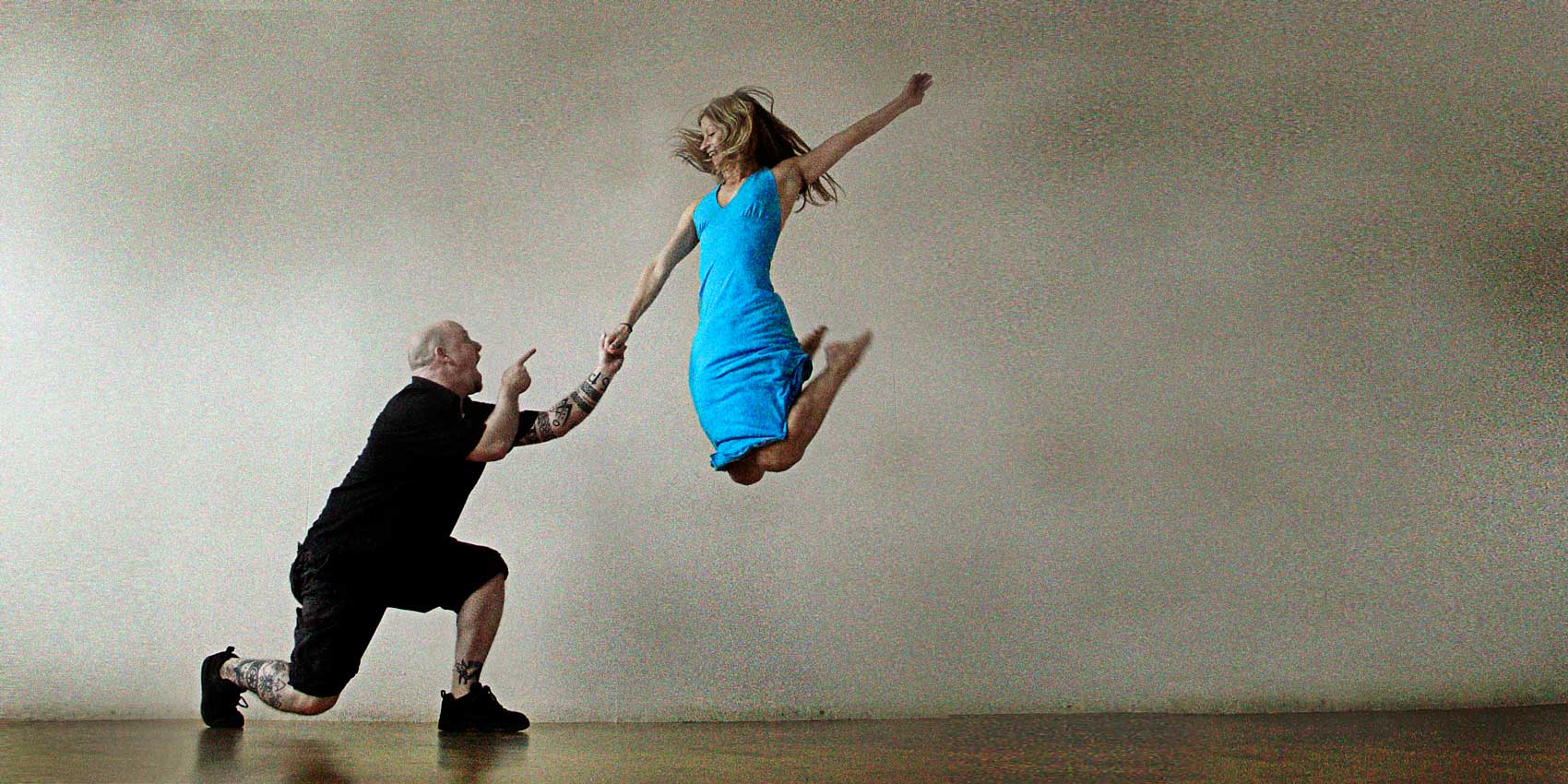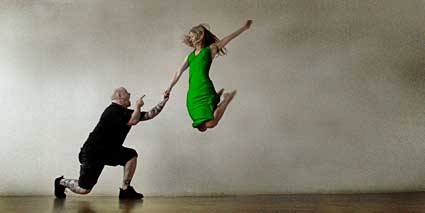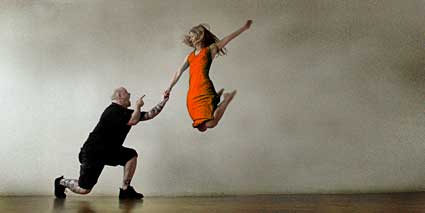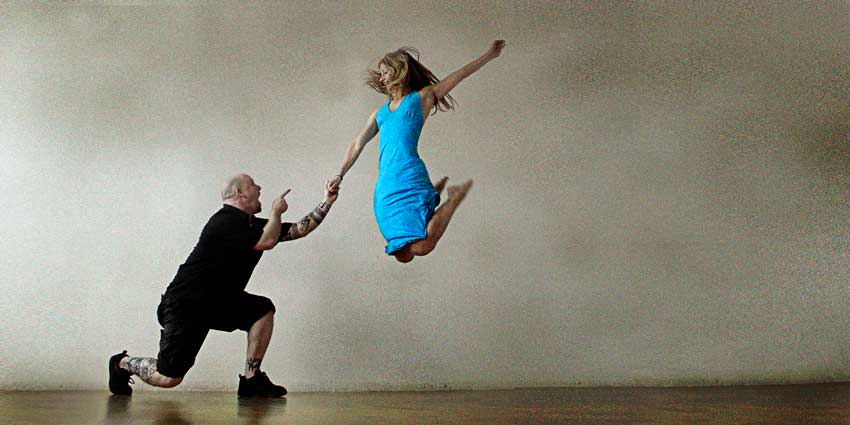Current Courses
2021-12-22 || Due to the Health Mandate all classes are currently suspended at the moment.
• East Coast Swing/Jitterbug styles and moves from Lindy Hop, Rock'n'Roll, Swing, Bop, Carolina Shag - taught in triple step.
• West Coast Swing.

Swing Dancing at studios1.ca with Gabby
Since 1996 Gabreïl has been teaching the East Coast Swing Styles courses that promote FUN and improvisation through a clean and concise approach. Contextualized with historical references, students learn and extrapolate essential concepts and moves of 6 and 8 count rhythm patterns (& 2s, 4s, 10s, 12s)from the various periods of swing.
Through the various levels participants are encouraged to develop their own styles and preferences within the confines of the social dancing Leading and Following ideals – while amassing an arsenal of awesome moves.
These courses are not anachronistic dance classes instead they are a series of graduating lessons that work on fundamentalss that allow students access to the foundations of swing types styles such as Lindy Hop, “Jitterbug”, Rock’n’Roll, Bop, etc. as well as West Coast Swing, plus the ballroom dance styles Foxtrot and Quickstep.
Starting to Tap Dance when he was wee, Gabby learned to Swing Dance for a play as a teenager. His infamous Sinful Sunday Swing classes held at Dancing on King, Toronto expanded, with the relocation of fellow instructor Lisa Jacobs to Vancouver, to the multi-styled Swing courses that were a fixture in the Toronto 90s Swing Revival. Ignoring the Revisionists and not particularly interested in the fads, Gabreil has continue to teach his comprehensive Swing courses to literally tens of thousands of students, age 5 to 85 across Canada and abroad.
Swing Dancing INFORMATION
We can offer a 4 Level graduated comprehensive Swing Dance Course of the East Coast Styles, that include Lindy Hop through the mid 20th Century styles up to Rock 'n' Roll. These courses are designed to make students confident with technical elements and the conventions of various types of Swing Dancing. All courses work on both the 6 and 8 count basic patterns in triple step with additional count basics, footwork and pattern variations introduced in the high levels.

Beginner
Intermediate
Intermediate +
Advanced
We on the rare occasion offer West Coast Swing classes, though you will immediately notice that we do not dance it the way some people learn in the ballroom studios. Due to the infrequence of time to schedule these classes in we actually suggest you check out the Urban Beat Dance Co.
History of Swing Dancing
Controversy at every tuck, turn and rock step, Swing Dance was developed around the turn of the 20th Century from the combination of existing dances like Charleston and Tap Dancing fused with the new partner dances that "Break-A-Way" to one hand holds and had lots of turning. One of the most popular styles was the Lindy Hop which became the basis for much of contemporary Swing.
Over time as interest in these new dances grew Swing Dance developed into many different dance styles with various music types and regional influences leaving their mark on the dance, such as Jitterbug, Jive, "West Coast", Boogie Woogie, Shag, Bop and Rock 'n' Roll. What makes Swing Dance so popular is the improvisational music inspired approach that encourages the dancers to develop your own style while looking awesome and having a great while dancing it.
The influence of Swing Dance, paralleled with the rise of 20th Century American Western culture, has influenced much of the Latin and Ballroom partner dances taught today. While newer forms such as Ceroc/Leroc and the aptly named Modern Jive combine Swing Dance styles with Latin Dance styles in contrast to the older romantic Lindy Hop, Swing Dance continues to be a popular social dance internationally.
East Coast Swing Styles
The term was originally used as the name of a Swing Dance style created in 1940s as a "refined" form of Jitterbug/Lindy Hop, Designed by the American Ballroom teachers with simplified moves and less of the outlandish erotic acrobatics found in the Dance Clubs. This was short lived as over time students quickly demanded the Swing styles they saw in dance halls and for that many of the original moves made their way back into the dance. Today East Coast Swing is often used as both a synonym for the type of swing taught in some Ballroom Dance Studios or, like we continue to use it at studios1.ca, an umbrella term for dance styles primarily from the American East Coast such as Jitterbug, Jive, Lindy Hop and Rock 'n' Roll - to name a few. The flexibility of this dance allows it to be danced to a whole range of music from Jazz and Big Band to contemporary Rock music.
West Coast Swing
Due to the infrequence of time to schedule these classes in we actually suggest you check out the Urban Beat Dance Co.
There are many different theories on why West Coast Swing is danced in a slot formation. Attributed to Dean Collins (he denied this) who brought the Swing Dance from New York to California, the basis of Lindy Hop was influenced by Latin Dance styles to create the tell-tale moves and stylings of this dance. Sexy and provocative the dance is commonly known to be danced to R&B. As music styles changed the West Coast Swing adapted and is now also danced to Hip Hop, Funk and Disco. Most notably West Coast Swing was a heavy influence on the dance Hustle.
Charleston & Balboa - not taught
It is difficult to not think of the Charleston without envisioning the rebellious culture of the New York City Roaring Twenties during Prohibition. A simple foot work pattern of Afro-American roots know for syncopated pops and kicks with alternating inward-outward rotation of the legs it is no wonder that the Charleston would be incorporated and stylized into, and eventually overshadowed by Lindy Hop where it remains popular today.
Also stemming from the Charleston, Balboa was a swing dance contemporary of Lindy Hop. Noted for the "closed position" the dancers remain in while dancing it was often regarded as a Charleston type revival that was eclipsed (and often out right banned) on the dance floor by Lindy Hop. Although Gabby does not teach Balboa, he teaches several Balboa inspired moves - because they're just so awesome - in the Intermediate and Advance Levels in addition to the Lindy Hop Charleston Patterns in all the Levels.





